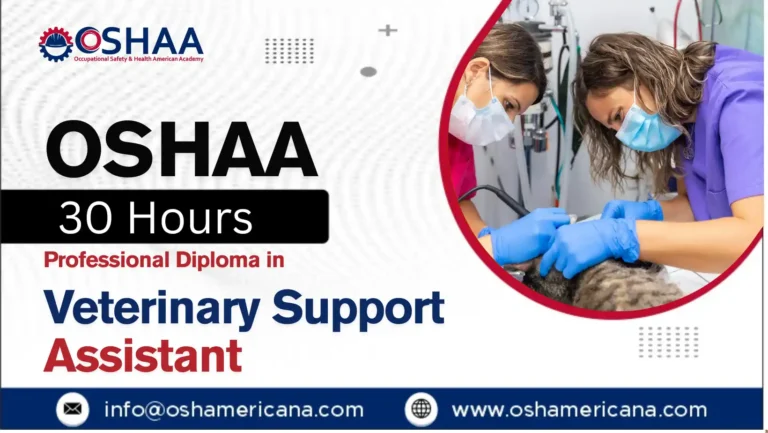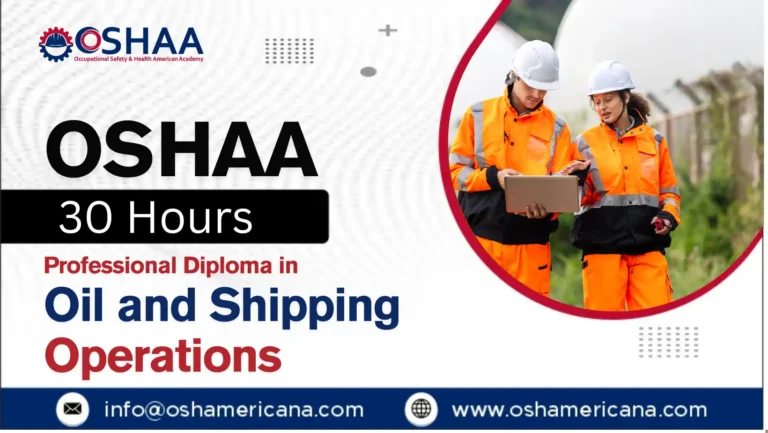Advance your career with the OSHA 132-Hour Construction Safety and Health course, mastering construction site safety, compliance, and professional development.
In the high-stakes and fast-paced world of construction, ensuring safety is not merely a regulatory obligation—it is a critical professional responsibility. The OSHA 132-Hour Construction Safety and Health course is an advanced and comprehensive program designed to equip construction professionals with the expertise, practical skills, and certifications necessary to navigate and mitigate the unique risks found on construction sites. This intensive training empowers participants to apply OSHA standards effectively, fostering safer workplaces and enhancing overall operational efficiency.
The OSHA 132-Hour Construction Safety and Health course offers an in-depth exploration of occupational safety and health principles as they apply specifically to construction environments. Participants gain a thorough understanding of OSHA regulations and compliance requirements, enabling them to identify, assess, and manage hazards across a wide range of construction activities, including excavation, scaffolding, and building erection. By mastering these regulations, professionals can ensure that their worksites not only meet legal standards but also uphold the highest levels of safety and accountability.
A key focus of the OSHA 132-Hour Construction Safety and Health course is cultivating leadership and safety management skills essential for fostering a strong safety culture. Learners will explore practical strategies for conducting site audits, performing thorough inspections, and implementing corrective measures to address non-compliance or potential hazards. By integrating these skills, construction managers, supervisors, and safety officers can lead teams with confidence, promoting awareness, responsibility, and proactive risk management across all levels of a project.
Moreover, the OSHA 132-Hour Construction Safety and Health course emphasizes professional development and career advancement. Graduates emerge with a robust skill set that enhances their credentials and marketability within the construction industry. This program is ideal for construction managers, site supervisors, safety officers, and other professionals seeking to deepen their expertise in occupational safety, achieve compliance with OSHA standards, and champion the highest levels of workplace safety. By completing this course, participants gain the knowledge and authority to implement effective safety programs, reduce workplace incidents, and contribute to a culture of continuous safety improvement.
Overall, the OSHA 132-Hour Construction Safety and Health course represents an essential investment for any construction professional committed to excellence in safety, compliance, and leadership. Through a combination of regulatory knowledge, practical application, and strategic safety management, participants are prepared to meet the complex challenges of modern construction environments while promoting sustainable, safe, and efficient operations.
OSHA 132-Hour Construction Safety and Health
To enroll in the OSHA 132-Hour Construction Safety and Health, learners are expected to meet the following criteria:
- Age Requirement – Participants must be at least 18 years of age at the time of enrollment. The OSHA 132-Hour Construction Safety and Health course is designed for adult learners who are prepared to engage with advanced safety and compliance concepts in construction environments.
- Educational Background – A high school diploma or equivalent is strongly recommended for enrollment in the OSHA 132-Hour Construction Safety and Health course. Individuals with post-secondary education in construction management, engineering, occupational safety, or related fields will find this background advantageous in understanding the technical and regulatory components of the program.
- Work Experience – While prior work experience in construction or safety management is not strictly required, it is recommended for learners enrolling in the OSHA 132-Hour Construction Safety and Health course. Practical experience can enhance comprehension of construction site hazards, safety protocols, and the application of OSHA regulations covered throughout the training.
- English Proficiency – Learners must be able to read, write, and communicate effectively in English to fully understand the course materials, regulatory standards, and assessment requirements. Proficiency in English ensures that participants can engage with OSHA guidelines and safety documentation with clarity and accuracy throughout the OSHA 132-Hour Construction Safety and Health program.
The OSHA 132-Hour Construction Safety and Health course is structured to accommodate professionals who meet these eligibility requirements, ensuring that participants are well-prepared to gain comprehensive knowledge in construction safety, regulatory compliance, and effective risk management.
Study Units
Learning Outcomes
The OSHA 132-Hour Construction Safety and Health course is designed to equip learners with advanced skills, comprehensive compliance knowledge, and effective safety leadership abilities essential for managing construction site hazards. By completing this program, participants will gain the expertise to implement OSHA standards, enhance workplace safety, and lead initiatives that foster a strong safety culture across all construction operations.
- Introduction to OSHA and Construction Safety
- Understand the critical role of OSHA in regulating safety standards specific to the construction industry.
- Identify key OSHA regulations applicable to construction sites and interpret their implications for employers and workers.
- Explain the importance of safety management systems in maintaining safe work environments across construction projects.
- Regulatory Compliance in Construction
- Interpret and apply OSHA standards (29 CFR Part 1926) to ensure comprehensive compliance across various construction activities.
- Develop effective strategies to address compliance challenges related to scaffolding, fall protection, electrical safety, and other critical hazards.
- Analyze real-world case studies to navigate complex regulatory scenarios and implement corrective measures efficiently.
- Hazard Identification and Risk Assessment
- Utilize advanced techniques to identify and assess physical, chemical, and environmental hazards in construction settings.
- Prioritize risks based on severity and likelihood to develop effective mitigation strategies.
- Implement preventive controls to minimize hazards and enhance overall construction site safety.
- Process Safety Management (PSM)
- Explain the principles and OSHA requirements of Process Safety Management (29 CFR 1910.119) in construction activities.
- Implement PSM systems to manage hazardous processes and prevent major incidents involving chemicals or equipment.
- Conduct process hazard analyses (PHAs) and manage change processes to ensure ongoing compliance and safety.
- Emergency Preparedness and Response Planning
- Develop comprehensive emergency action plans (EAPs) tailored to site-specific construction hazards.
- Train personnel in emergency roles and procedures, including evacuation, first aid, and incident command.
- Conduct drills and simulations to evaluate the effectiveness of emergency response strategies and improve readiness.
- Health Hazards in Construction
- Identify common construction health hazards, including asbestos, silica, lead, and ergonomic risks.
- Implement protective measures to minimize exposure and promote worker health.
- Educate personnel on health hazards and foster proactive health management practices on construction sites.
- Environmental Protection and Sustainability
- Understand environmental regulations affecting construction projects and operations.
- Implement sustainable practices for waste management, pollution prevention, and resource conservation.
- Conduct environmental impact assessments and develop strategies to reduce ecological footprints.
- Safety Leadership and Culture
- Foster a robust safety culture within construction teams through effective leadership and communication.
- Promote safety awareness, accountability, and engagement at all levels of personnel.
- Lead by example to encourage continuous improvement in safety performance across construction sites.
- Advanced Personal Protective Equipment (PPE)
- Select and implement appropriate PPE for various construction tasks based on hazard assessments.
- Train workers on proper PPE usage, maintenance, and inspection to ensure compliance with safety standards.
- Evaluate and enhance PPE programs to maximize protection and minimize workplace risks.
- Safety Training and Education
- Design and deliver targeted safety training programs tailored to specific construction hazards and job roles.
- Assess training effectiveness through evaluations and feedback, making program adjustments as needed.
- Promote a culture of continuous learning and development in safety practices across construction personnel.
- Contractor and Vendor Safety Management
- Establish and enforce rigorous safety standards for contractors and vendors on construction projects.
- Monitor and audit contractor compliance with OSHA regulations and project-specific safety requirements.
- Collaborate with external stakeholders to ensure alignment with overall safety objectives and performance benchmarks.
- Regulatory Compliance and Auditing
- Conduct comprehensive audits and inspections to assess adherence to OSHA standards and regulatory requirements.
- Identify deficiencies, implement corrective actions, and ensure continuous compliance improvement.
- Maintain accurate documentation to demonstrate regulatory compliance and support inspection readiness.
Completing the OSHA 132-Hour Construction Safety and Health course prepares participants to lead safety initiatives effectively, ensure full regulatory compliance, and cultivate a strong culture of safety within construction organizations. Graduates emerge with the knowledge, skills, and leadership abilities necessary to proactively manage workplace hazards, promote health and safety standards, and drive continuous improvement in construction safety performance.
The OSHA 132-Hour Construction Safety and Health Course is a comprehensive training program designed to equip construction industry professionals with advanced knowledge, practical skills, and strategic approaches for managing workplace safety effectively. This extensive program is ideal for construction managers, safety officers, supervisors, and frontline workers seeking to enhance their expertise in hazard identification, regulatory compliance, and safety leadership. By providing in-depth coverage of OSHA standards and construction-specific safety protocols, the course empowers participants to reduce incidents, improve operational efficiency, and foster a culture of safety on job sites worldwide.
1. Advanced Knowledge and Skill Development
Gain in-depth expertise in construction safety principles, including hazard recognition, risk assessment, and accident prevention. Apply OSHA standards in practical scenarios to enhance on-site safety and decision-making.
2. Comprehensive Regulatory Compliance
Learn to interpret, implement, and maintain compliance with OSHA regulations specific to the construction industry. Avoid legal penalties and ensure adherence to evolving workplace safety requirements.
3. Workplace Incident Reduction
Identify and mitigate risks before they result in accidents. Implement advanced safety strategies to prevent falls, equipment-related injuries, and chemical exposure, fostering a safer work environment.
4. Professional Development and Career Advancement
Enhance your credentials in construction safety and health management. Open pathways to leadership roles, higher-level safety positions, and specialized compliance opportunities within the construction sector.
5. Effective Risk Management
Develop proactive strategies to evaluate hazards and reduce operational risks. Prioritize interventions based on severity and likelihood to minimize incidents and project delays.
6. Leadership and Safety Culture Enhancement
Promote a proactive safety culture by encouraging reporting, accountability, and engagement across teams. Strengthen leadership capabilities to manage safety programs and conduct effective safety briefings.
7. Cost Savings and Operational Efficiency
Reduce expenses associated with workplace injuries, compensation claims, and downtime. Maintain uninterrupted project timelines and improve productivity through structured safety management.
8. Emergency Preparedness and Response
Design and implement robust emergency action plans for construction sites. Conduct drills and training for fire, equipment, and chemical emergencies to ensure rapid and coordinated response.
9. Worker Health and Well-Being
Promote occupational health through wellness programs, ergonomic practices, and routine risk assessments. Enhance workforce morale and productivity by prioritizing safety and well-being.
10. Technology-Driven Safety Solutions
Utilize digital tools and safety management software to monitor hazards, track compliance, and generate actionable reports. Streamline processes and improve overall safety oversight.
11. Continuous Improvement in Safety Programs
Implement feedback loops, audits, and incident analyses to refine safety strategies continuously. Encourage innovation and adoption of best practices in construction safety management.
12. Effective Communication Skills
Develop the ability to clearly convey safety procedures, report hazards, and lead cross-functional teams. Build trust and accountability across all levels of the organization.
13. Environmental and Community Safety Awareness
Understand the environmental impact of construction activities and implement practices that protect surrounding communities. Promote sustainable safety practices aligned with corporate social responsibility goals.
14. Strategic Planning and Decision-Making
Integrate safety considerations into project planning and operational strategies. Enhance organizational resilience by anticipating and mitigating potential hazards.
15. Global Competency in Construction Safety
Gain internationally recognized expertise in construction safety standards. Equip yourself to work on multinational projects while adhering to globally accepted safety and health protocols.
The OSHA 132-Hour Construction Safety and Health course is designed for construction professionals, safety officers, project managers, and organizational leaders seeking advanced knowledge in workplace safety, regulatory compliance, and hazard management. This course is highly relevant to individuals and organizations responsible for ensuring OSHA compliance, maintaining operational efficiency, and promoting a strong safety culture across construction projects. By participating, learners gain globally recognized skills, professional certifications, and practical expertise that enhance safety performance and career development.
- Construction Safety Managers and Directors
- Oversee and implement safety programs across construction projects, ensuring adherence to OSHA standards and workplace safety regulations.
- Lead safety audits, inspections, and incident investigations to maintain compliance and prevent workplace hazards.
- Develop strategic safety plans and foster a culture of accountability and continuous improvement across teams.
- Enhance leadership and risk management skills through advanced OSHA training in construction safety.
- Site Supervisors and Foremen
- Directly manage day-to-day safety operations on construction sites, implementing protocols and best practices.
- Conduct toolbox talks, monitor worker activities, and enforce compliance with OSHA regulations.
- Identify and mitigate hazards on-site, reducing accidents and improving operational efficiency.
- Strengthen leadership capabilities and promote safety awareness among all personnel on the site.
- Health and Safety Professionals (HSE Officers)
- Specialize in occupational health and safety within construction, developing policies and safety procedures.
- Conduct risk assessments, hazard evaluations, and provide actionable recommendations to mitigate workplace risks.
- Deliver safety training programs and ensure ongoing compliance with OSHA standards.
- Enhance professional expertise and credibility through advanced knowledge in construction safety management.
- Contractors and Subcontractors
- Manage and execute construction tasks while ensuring workforce compliance with safety standards.
- Collaborate with site managers and safety professionals to maintain safe and compliant work environments.
- Integrate OSHA training principles into daily operations to prevent incidents and improve project outcomes.
- Gain recognition for adhering to rigorous safety practices, fostering trust with clients and stakeholders.
- Safety Consultants and Advisors
- Provide expert guidance on construction safety management and regulatory compliance.
- Assist organizations in designing, implementing, and improving safety programs.
- Conduct audits, training, and compliance assessments to support operational excellence.
- Strengthen advisory skills and professional credibility in OSHA-regulated construction environments.
- Environmental Health Specialists
- Focus on sustainability and environmental protection within construction operations.
- Manage waste disposal, pollution prevention, and compliance with environmental regulations.
- Implement best practices to minimize the ecological impact of construction activities.
- Enhance expertise in integrating safety, health, and environmental standards into project management.
- Regulatory Compliance Officers
- Ensure construction sites meet local, state, and federal OSHA safety requirements.
- Conduct inspections, audits, and assessments to verify compliance and address deficiencies.
- Develop corrective action plans to maintain regulatory adherence and workplace safety.
- Build professional authority in compliance management and occupational safety standards.
- Construction Project Managers
- Oversee project execution while integrating safety considerations into scheduling, budgeting, and resource allocation.
- Collaborate with safety officers to identify risks and maintain project timelines without compromising safety.
- Implement OSHA regulations across all project phases, ensuring both compliance and efficiency.
- Develop leadership and decision-making skills in managing safety-critical construction operations.
The OSHA 132-Hour Construction Safety and Health course equips professionals across all levels of the construction industry with advanced safety management knowledge, practical skills, and recognized certifications. By completing this program, participants are empowered to lead workplace safety initiatives, ensure OSHA compliance, and foster a culture of safety excellence, contributing to safer, more efficient, and sustainable construction projects globally.







